Project Management Report: Royal Adelaide Hospital Project Analysis
VerifiedAdded on 2021/04/17
|11
|2676
|126
Report
AI Summary
This report analyzes the project management aspects of the New Royal Adelaide Hospital (RAH), a large-scale Public Private Partnership (PPP) project. The report examines the procurement context, highlighting challenges such as project delays, cost pressures, insufficient staff training, and industrial disputes. It identifies key risks and mitigation strategies, including the impact of contractual arrangements and the importance of effective governance through an assurance framework. The report summarizes key findings from audit governance reports, emphasizing the need for improved budget management, risk management, and contract administration. It also details best practices such as strategic acquisition planning and the roles and responsibilities of project managers. Finally, the report includes a reflection journal, discussing the learnings from modules on contracts, procurement, project governance, and the importance of research and analysis in professional contexts.
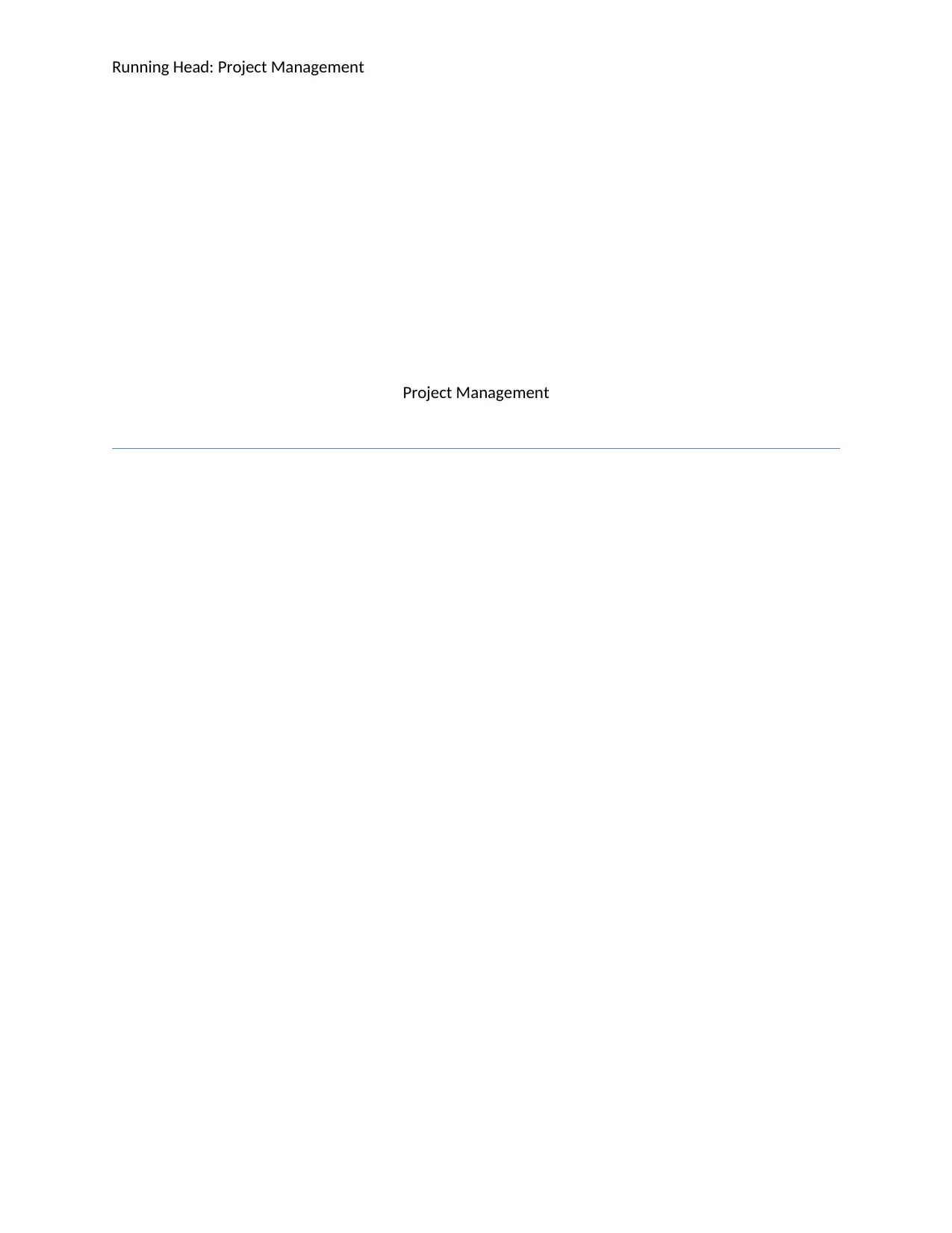
Running Head: Project Management
Project Management
Project Management
Paraphrase This Document
Need a fresh take? Get an instant paraphrase of this document with our AI Paraphraser
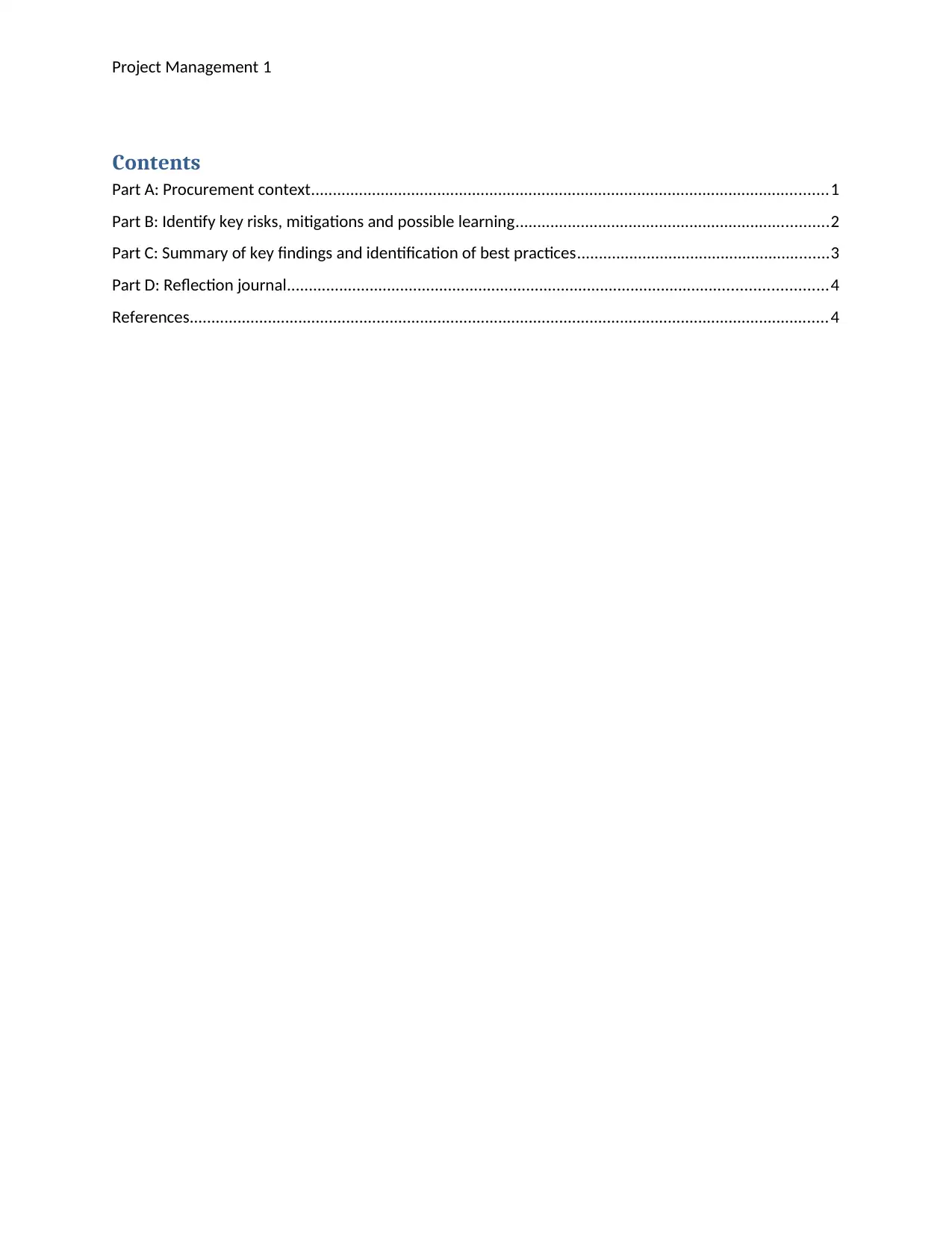
Project Management 1
Contents
Part A: Procurement context.......................................................................................................................1
Part B: Identify key risks, mitigations and possible learning........................................................................2
Part C: Summary of key findings and identification of best practices..........................................................3
Part D: Reflection journal............................................................................................................................4
References...................................................................................................................................................4
Contents
Part A: Procurement context.......................................................................................................................1
Part B: Identify key risks, mitigations and possible learning........................................................................2
Part C: Summary of key findings and identification of best practices..........................................................3
Part D: Reflection journal............................................................................................................................4
References...................................................................................................................................................4
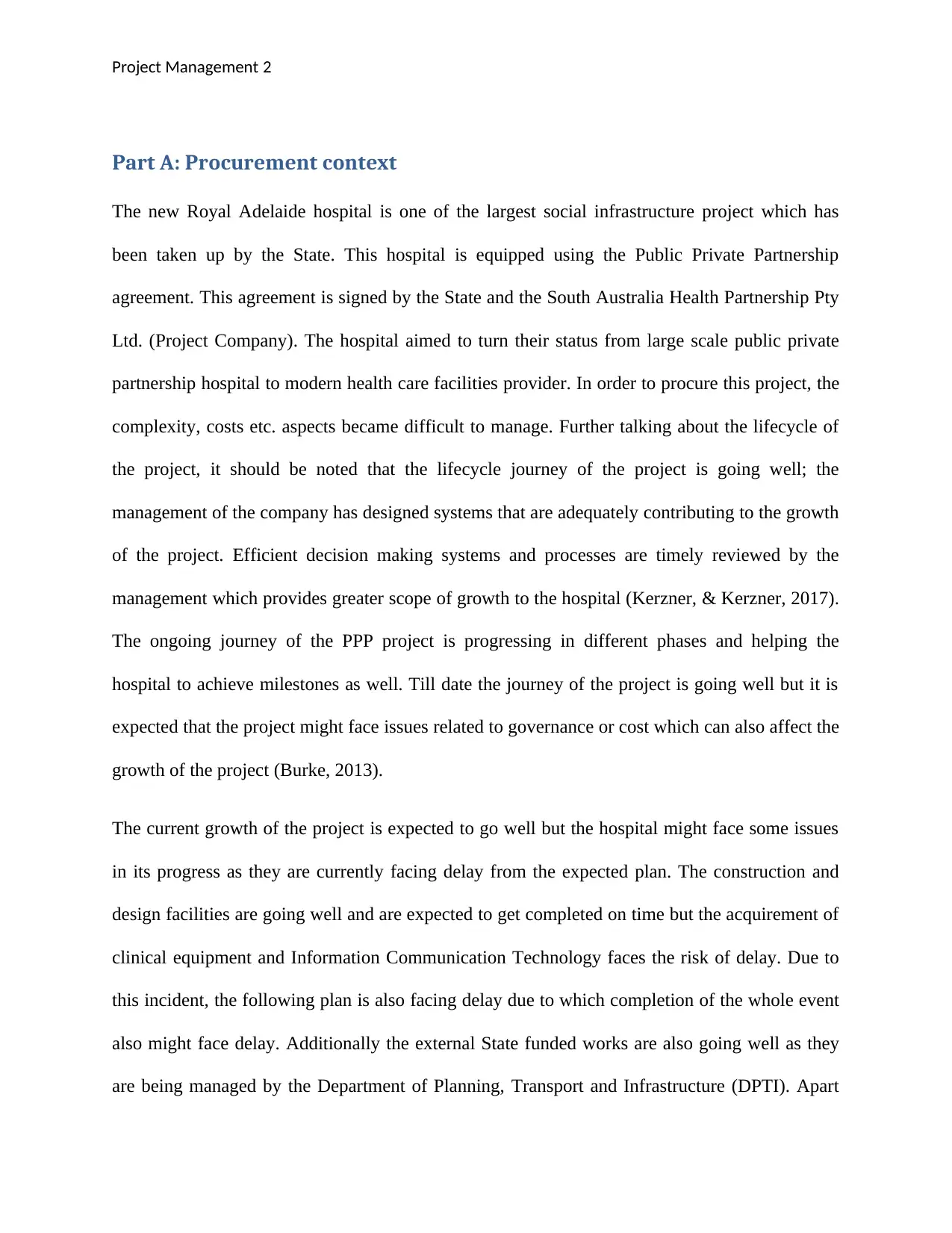
Project Management 2
Part A: Procurement context
The new Royal Adelaide hospital is one of the largest social infrastructure project which has
been taken up by the State. This hospital is equipped using the Public Private Partnership
agreement. This agreement is signed by the State and the South Australia Health Partnership Pty
Ltd. (Project Company). The hospital aimed to turn their status from large scale public private
partnership hospital to modern health care facilities provider. In order to procure this project, the
complexity, costs etc. aspects became difficult to manage. Further talking about the lifecycle of
the project, it should be noted that the lifecycle journey of the project is going well; the
management of the company has designed systems that are adequately contributing to the growth
of the project. Efficient decision making systems and processes are timely reviewed by the
management which provides greater scope of growth to the hospital (Kerzner, & Kerzner, 2017).
The ongoing journey of the PPP project is progressing in different phases and helping the
hospital to achieve milestones as well. Till date the journey of the project is going well but it is
expected that the project might face issues related to governance or cost which can also affect the
growth of the project (Burke, 2013).
The current growth of the project is expected to go well but the hospital might face some issues
in its progress as they are currently facing delay from the expected plan. The construction and
design facilities are going well and are expected to get completed on time but the acquirement of
clinical equipment and Information Communication Technology faces the risk of delay. Due to
this incident, the following plan is also facing delay due to which completion of the whole event
also might face delay. Additionally the external State funded works are also going well as they
are being managed by the Department of Planning, Transport and Infrastructure (DPTI). Apart
Part A: Procurement context
The new Royal Adelaide hospital is one of the largest social infrastructure project which has
been taken up by the State. This hospital is equipped using the Public Private Partnership
agreement. This agreement is signed by the State and the South Australia Health Partnership Pty
Ltd. (Project Company). The hospital aimed to turn their status from large scale public private
partnership hospital to modern health care facilities provider. In order to procure this project, the
complexity, costs etc. aspects became difficult to manage. Further talking about the lifecycle of
the project, it should be noted that the lifecycle journey of the project is going well; the
management of the company has designed systems that are adequately contributing to the growth
of the project. Efficient decision making systems and processes are timely reviewed by the
management which provides greater scope of growth to the hospital (Kerzner, & Kerzner, 2017).
The ongoing journey of the PPP project is progressing in different phases and helping the
hospital to achieve milestones as well. Till date the journey of the project is going well but it is
expected that the project might face issues related to governance or cost which can also affect the
growth of the project (Burke, 2013).
The current growth of the project is expected to go well but the hospital might face some issues
in its progress as they are currently facing delay from the expected plan. The construction and
design facilities are going well and are expected to get completed on time but the acquirement of
clinical equipment and Information Communication Technology faces the risk of delay. Due to
this incident, the following plan is also facing delay due to which completion of the whole event
also might face delay. Additionally the external State funded works are also going well as they
are being managed by the Department of Planning, Transport and Infrastructure (DPTI). Apart
⊘ This is a preview!⊘
Do you want full access?
Subscribe today to unlock all pages.

Trusted by 1+ million students worldwide
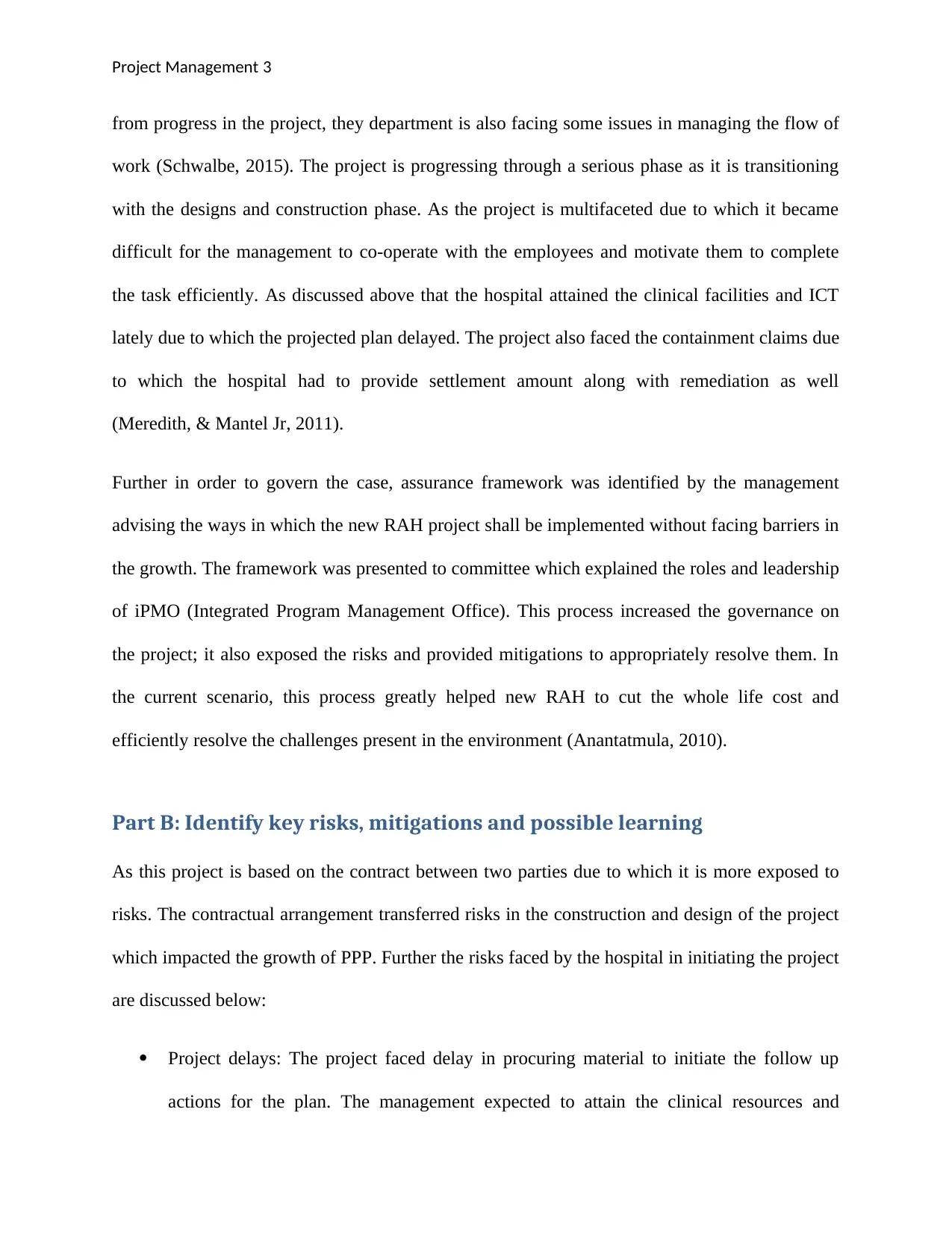
Project Management 3
from progress in the project, they department is also facing some issues in managing the flow of
work (Schwalbe, 2015). The project is progressing through a serious phase as it is transitioning
with the designs and construction phase. As the project is multifaceted due to which it became
difficult for the management to co-operate with the employees and motivate them to complete
the task efficiently. As discussed above that the hospital attained the clinical facilities and ICT
lately due to which the projected plan delayed. The project also faced the containment claims due
to which the hospital had to provide settlement amount along with remediation as well
(Meredith, & Mantel Jr, 2011).
Further in order to govern the case, assurance framework was identified by the management
advising the ways in which the new RAH project shall be implemented without facing barriers in
the growth. The framework was presented to committee which explained the roles and leadership
of iPMO (Integrated Program Management Office). This process increased the governance on
the project; it also exposed the risks and provided mitigations to appropriately resolve them. In
the current scenario, this process greatly helped new RAH to cut the whole life cost and
efficiently resolve the challenges present in the environment (Anantatmula, 2010).
Part B: Identify key risks, mitigations and possible learning
As this project is based on the contract between two parties due to which it is more exposed to
risks. The contractual arrangement transferred risks in the construction and design of the project
which impacted the growth of PPP. Further the risks faced by the hospital in initiating the project
are discussed below:
Project delays: The project faced delay in procuring material to initiate the follow up
actions for the plan. The management expected to attain the clinical resources and
from progress in the project, they department is also facing some issues in managing the flow of
work (Schwalbe, 2015). The project is progressing through a serious phase as it is transitioning
with the designs and construction phase. As the project is multifaceted due to which it became
difficult for the management to co-operate with the employees and motivate them to complete
the task efficiently. As discussed above that the hospital attained the clinical facilities and ICT
lately due to which the projected plan delayed. The project also faced the containment claims due
to which the hospital had to provide settlement amount along with remediation as well
(Meredith, & Mantel Jr, 2011).
Further in order to govern the case, assurance framework was identified by the management
advising the ways in which the new RAH project shall be implemented without facing barriers in
the growth. The framework was presented to committee which explained the roles and leadership
of iPMO (Integrated Program Management Office). This process increased the governance on
the project; it also exposed the risks and provided mitigations to appropriately resolve them. In
the current scenario, this process greatly helped new RAH to cut the whole life cost and
efficiently resolve the challenges present in the environment (Anantatmula, 2010).
Part B: Identify key risks, mitigations and possible learning
As this project is based on the contract between two parties due to which it is more exposed to
risks. The contractual arrangement transferred risks in the construction and design of the project
which impacted the growth of PPP. Further the risks faced by the hospital in initiating the project
are discussed below:
Project delays: The project faced delay in procuring material to initiate the follow up
actions for the plan. The management expected to attain the clinical resources and
Paraphrase This Document
Need a fresh take? Get an instant paraphrase of this document with our AI Paraphraser
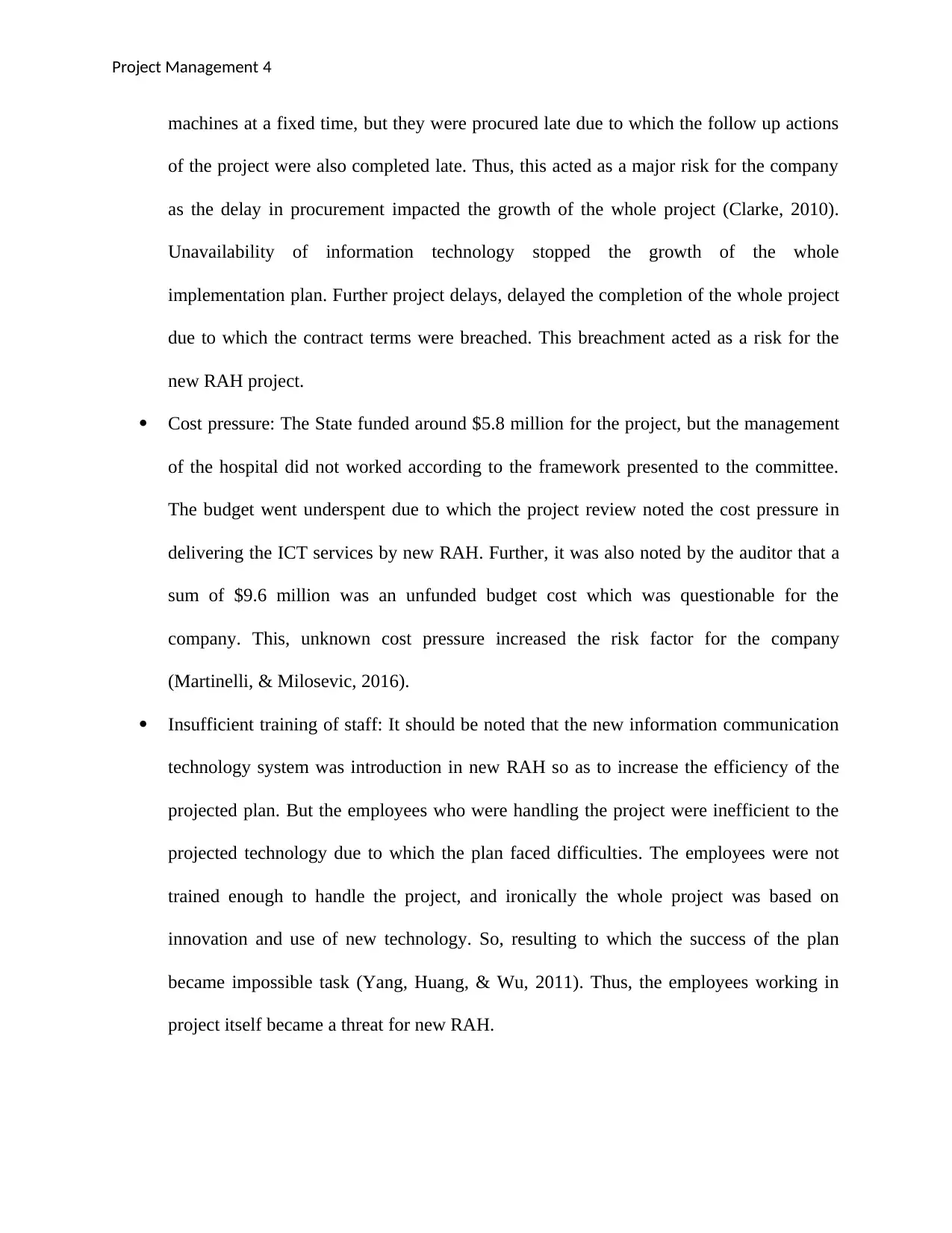
Project Management 4
machines at a fixed time, but they were procured late due to which the follow up actions
of the project were also completed late. Thus, this acted as a major risk for the company
as the delay in procurement impacted the growth of the whole project (Clarke, 2010).
Unavailability of information technology stopped the growth of the whole
implementation plan. Further project delays, delayed the completion of the whole project
due to which the contract terms were breached. This breachment acted as a risk for the
new RAH project.
Cost pressure: The State funded around $5.8 million for the project, but the management
of the hospital did not worked according to the framework presented to the committee.
The budget went underspent due to which the project review noted the cost pressure in
delivering the ICT services by new RAH. Further, it was also noted by the auditor that a
sum of $9.6 million was an unfunded budget cost which was questionable for the
company. This, unknown cost pressure increased the risk factor for the company
(Martinelli, & Milosevic, 2016).
Insufficient training of staff: It should be noted that the new information communication
technology system was introduction in new RAH so as to increase the efficiency of the
projected plan. But the employees who were handling the project were inefficient to the
projected technology due to which the plan faced difficulties. The employees were not
trained enough to handle the project, and ironically the whole project was based on
innovation and use of new technology. So, resulting to which the success of the plan
became impossible task (Yang, Huang, & Wu, 2011). Thus, the employees working in
project itself became a threat for new RAH.
machines at a fixed time, but they were procured late due to which the follow up actions
of the project were also completed late. Thus, this acted as a major risk for the company
as the delay in procurement impacted the growth of the whole project (Clarke, 2010).
Unavailability of information technology stopped the growth of the whole
implementation plan. Further project delays, delayed the completion of the whole project
due to which the contract terms were breached. This breachment acted as a risk for the
new RAH project.
Cost pressure: The State funded around $5.8 million for the project, but the management
of the hospital did not worked according to the framework presented to the committee.
The budget went underspent due to which the project review noted the cost pressure in
delivering the ICT services by new RAH. Further, it was also noted by the auditor that a
sum of $9.6 million was an unfunded budget cost which was questionable for the
company. This, unknown cost pressure increased the risk factor for the company
(Martinelli, & Milosevic, 2016).
Insufficient training of staff: It should be noted that the new information communication
technology system was introduction in new RAH so as to increase the efficiency of the
projected plan. But the employees who were handling the project were inefficient to the
projected technology due to which the plan faced difficulties. The employees were not
trained enough to handle the project, and ironically the whole project was based on
innovation and use of new technology. So, resulting to which the success of the plan
became impossible task (Yang, Huang, & Wu, 2011). Thus, the employees working in
project itself became a threat for new RAH.
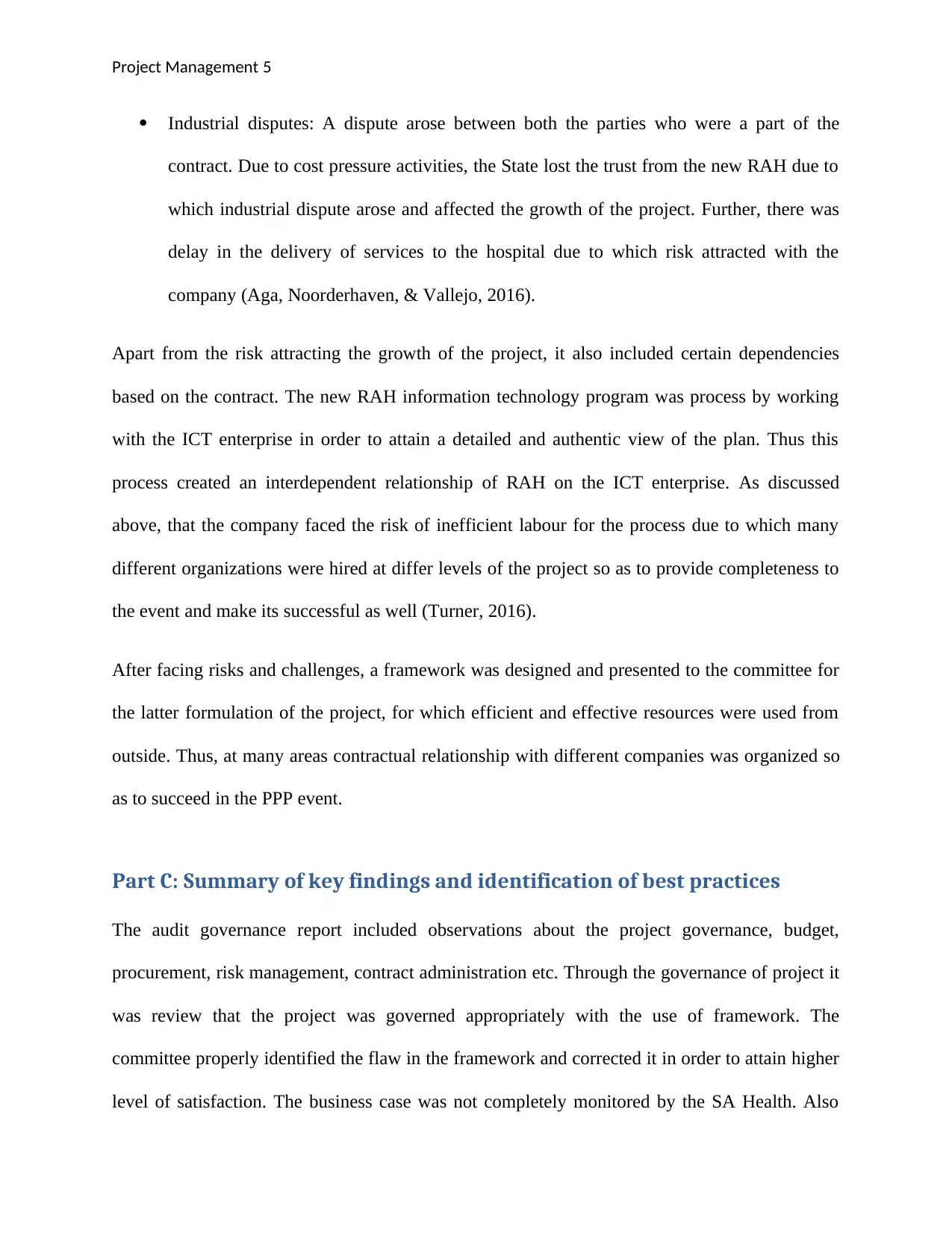
Project Management 5
Industrial disputes: A dispute arose between both the parties who were a part of the
contract. Due to cost pressure activities, the State lost the trust from the new RAH due to
which industrial dispute arose and affected the growth of the project. Further, there was
delay in the delivery of services to the hospital due to which risk attracted with the
company (Aga, Noorderhaven, & Vallejo, 2016).
Apart from the risk attracting the growth of the project, it also included certain dependencies
based on the contract. The new RAH information technology program was process by working
with the ICT enterprise in order to attain a detailed and authentic view of the plan. Thus this
process created an interdependent relationship of RAH on the ICT enterprise. As discussed
above, that the company faced the risk of inefficient labour for the process due to which many
different organizations were hired at differ levels of the project so as to provide completeness to
the event and make its successful as well (Turner, 2016).
After facing risks and challenges, a framework was designed and presented to the committee for
the latter formulation of the project, for which efficient and effective resources were used from
outside. Thus, at many areas contractual relationship with different companies was organized so
as to succeed in the PPP event.
Part C: Summary of key findings and identification of best practices
The audit governance report included observations about the project governance, budget,
procurement, risk management, contract administration etc. Through the governance of project it
was review that the project was governed appropriately with the use of framework. The
committee properly identified the flaw in the framework and corrected it in order to attain higher
level of satisfaction. The business case was not completely monitored by the SA Health. Also
Industrial disputes: A dispute arose between both the parties who were a part of the
contract. Due to cost pressure activities, the State lost the trust from the new RAH due to
which industrial dispute arose and affected the growth of the project. Further, there was
delay in the delivery of services to the hospital due to which risk attracted with the
company (Aga, Noorderhaven, & Vallejo, 2016).
Apart from the risk attracting the growth of the project, it also included certain dependencies
based on the contract. The new RAH information technology program was process by working
with the ICT enterprise in order to attain a detailed and authentic view of the plan. Thus this
process created an interdependent relationship of RAH on the ICT enterprise. As discussed
above, that the company faced the risk of inefficient labour for the process due to which many
different organizations were hired at differ levels of the project so as to provide completeness to
the event and make its successful as well (Turner, 2016).
After facing risks and challenges, a framework was designed and presented to the committee for
the latter formulation of the project, for which efficient and effective resources were used from
outside. Thus, at many areas contractual relationship with different companies was organized so
as to succeed in the PPP event.
Part C: Summary of key findings and identification of best practices
The audit governance report included observations about the project governance, budget,
procurement, risk management, contract administration etc. Through the governance of project it
was review that the project was governed appropriately with the use of framework. The
committee properly identified the flaw in the framework and corrected it in order to attain higher
level of satisfaction. The business case was not completely monitored by the SA Health. Also
⊘ This is a preview!⊘
Do you want full access?
Subscribe today to unlock all pages.

Trusted by 1+ million students worldwide
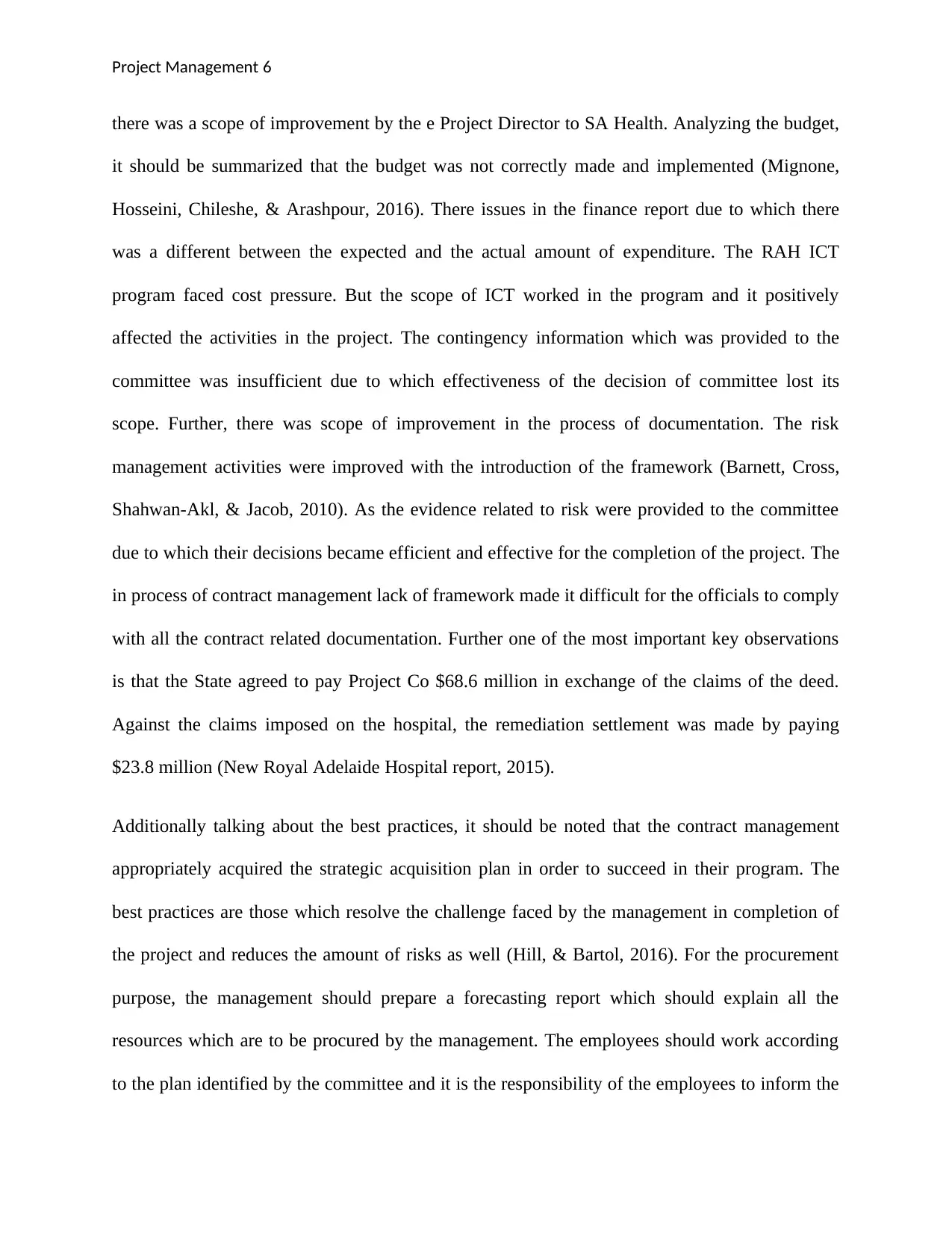
Project Management 6
there was a scope of improvement by the e Project Director to SA Health. Analyzing the budget,
it should be summarized that the budget was not correctly made and implemented (Mignone,
Hosseini, Chileshe, & Arashpour, 2016). There issues in the finance report due to which there
was a different between the expected and the actual amount of expenditure. The RAH ICT
program faced cost pressure. But the scope of ICT worked in the program and it positively
affected the activities in the project. The contingency information which was provided to the
committee was insufficient due to which effectiveness of the decision of committee lost its
scope. Further, there was scope of improvement in the process of documentation. The risk
management activities were improved with the introduction of the framework (Barnett, Cross,
Shahwan-Akl, & Jacob, 2010). As the evidence related to risk were provided to the committee
due to which their decisions became efficient and effective for the completion of the project. The
in process of contract management lack of framework made it difficult for the officials to comply
with all the contract related documentation. Further one of the most important key observations
is that the State agreed to pay Project Co $68.6 million in exchange of the claims of the deed.
Against the claims imposed on the hospital, the remediation settlement was made by paying
$23.8 million (New Royal Adelaide Hospital report, 2015).
Additionally talking about the best practices, it should be noted that the contract management
appropriately acquired the strategic acquisition plan in order to succeed in their program. The
best practices are those which resolve the challenge faced by the management in completion of
the project and reduces the amount of risks as well (Hill, & Bartol, 2016). For the procurement
purpose, the management should prepare a forecasting report which should explain all the
resources which are to be procured by the management. The employees should work according
to the plan identified by the committee and it is the responsibility of the employees to inform the
there was a scope of improvement by the e Project Director to SA Health. Analyzing the budget,
it should be summarized that the budget was not correctly made and implemented (Mignone,
Hosseini, Chileshe, & Arashpour, 2016). There issues in the finance report due to which there
was a different between the expected and the actual amount of expenditure. The RAH ICT
program faced cost pressure. But the scope of ICT worked in the program and it positively
affected the activities in the project. The contingency information which was provided to the
committee was insufficient due to which effectiveness of the decision of committee lost its
scope. Further, there was scope of improvement in the process of documentation. The risk
management activities were improved with the introduction of the framework (Barnett, Cross,
Shahwan-Akl, & Jacob, 2010). As the evidence related to risk were provided to the committee
due to which their decisions became efficient and effective for the completion of the project. The
in process of contract management lack of framework made it difficult for the officials to comply
with all the contract related documentation. Further one of the most important key observations
is that the State agreed to pay Project Co $68.6 million in exchange of the claims of the deed.
Against the claims imposed on the hospital, the remediation settlement was made by paying
$23.8 million (New Royal Adelaide Hospital report, 2015).
Additionally talking about the best practices, it should be noted that the contract management
appropriately acquired the strategic acquisition plan in order to succeed in their program. The
best practices are those which resolve the challenge faced by the management in completion of
the project and reduces the amount of risks as well (Hill, & Bartol, 2016). For the procurement
purpose, the management should prepare a forecasting report which should explain all the
resources which are to be procured by the management. The employees should work according
to the plan identified by the committee and it is the responsibility of the employees to inform the
Paraphrase This Document
Need a fresh take? Get an instant paraphrase of this document with our AI Paraphraser
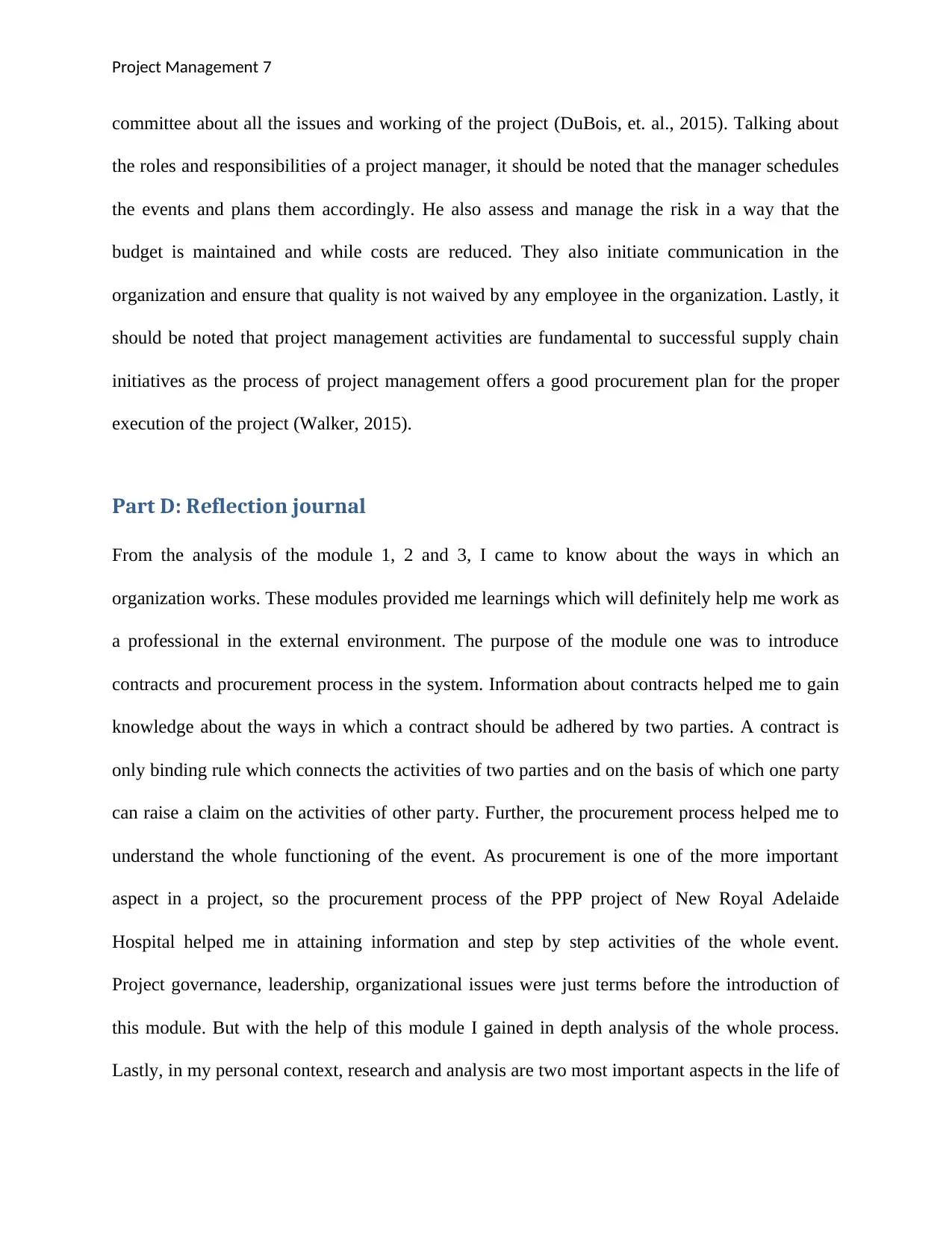
Project Management 7
committee about all the issues and working of the project (DuBois, et. al., 2015). Talking about
the roles and responsibilities of a project manager, it should be noted that the manager schedules
the events and plans them accordingly. He also assess and manage the risk in a way that the
budget is maintained and while costs are reduced. They also initiate communication in the
organization and ensure that quality is not waived by any employee in the organization. Lastly, it
should be noted that project management activities are fundamental to successful supply chain
initiatives as the process of project management offers a good procurement plan for the proper
execution of the project (Walker, 2015).
Part D: Reflection journal
From the analysis of the module 1, 2 and 3, I came to know about the ways in which an
organization works. These modules provided me learnings which will definitely help me work as
a professional in the external environment. The purpose of the module one was to introduce
contracts and procurement process in the system. Information about contracts helped me to gain
knowledge about the ways in which a contract should be adhered by two parties. A contract is
only binding rule which connects the activities of two parties and on the basis of which one party
can raise a claim on the activities of other party. Further, the procurement process helped me to
understand the whole functioning of the event. As procurement is one of the more important
aspect in a project, so the procurement process of the PPP project of New Royal Adelaide
Hospital helped me in attaining information and step by step activities of the whole event.
Project governance, leadership, organizational issues were just terms before the introduction of
this module. But with the help of this module I gained in depth analysis of the whole process.
Lastly, in my personal context, research and analysis are two most important aspects in the life of
committee about all the issues and working of the project (DuBois, et. al., 2015). Talking about
the roles and responsibilities of a project manager, it should be noted that the manager schedules
the events and plans them accordingly. He also assess and manage the risk in a way that the
budget is maintained and while costs are reduced. They also initiate communication in the
organization and ensure that quality is not waived by any employee in the organization. Lastly, it
should be noted that project management activities are fundamental to successful supply chain
initiatives as the process of project management offers a good procurement plan for the proper
execution of the project (Walker, 2015).
Part D: Reflection journal
From the analysis of the module 1, 2 and 3, I came to know about the ways in which an
organization works. These modules provided me learnings which will definitely help me work as
a professional in the external environment. The purpose of the module one was to introduce
contracts and procurement process in the system. Information about contracts helped me to gain
knowledge about the ways in which a contract should be adhered by two parties. A contract is
only binding rule which connects the activities of two parties and on the basis of which one party
can raise a claim on the activities of other party. Further, the procurement process helped me to
understand the whole functioning of the event. As procurement is one of the more important
aspect in a project, so the procurement process of the PPP project of New Royal Adelaide
Hospital helped me in attaining information and step by step activities of the whole event.
Project governance, leadership, organizational issues were just terms before the introduction of
this module. But with the help of this module I gained in depth analysis of the whole process.
Lastly, in my personal context, research and analysis are two most important aspects in the life of
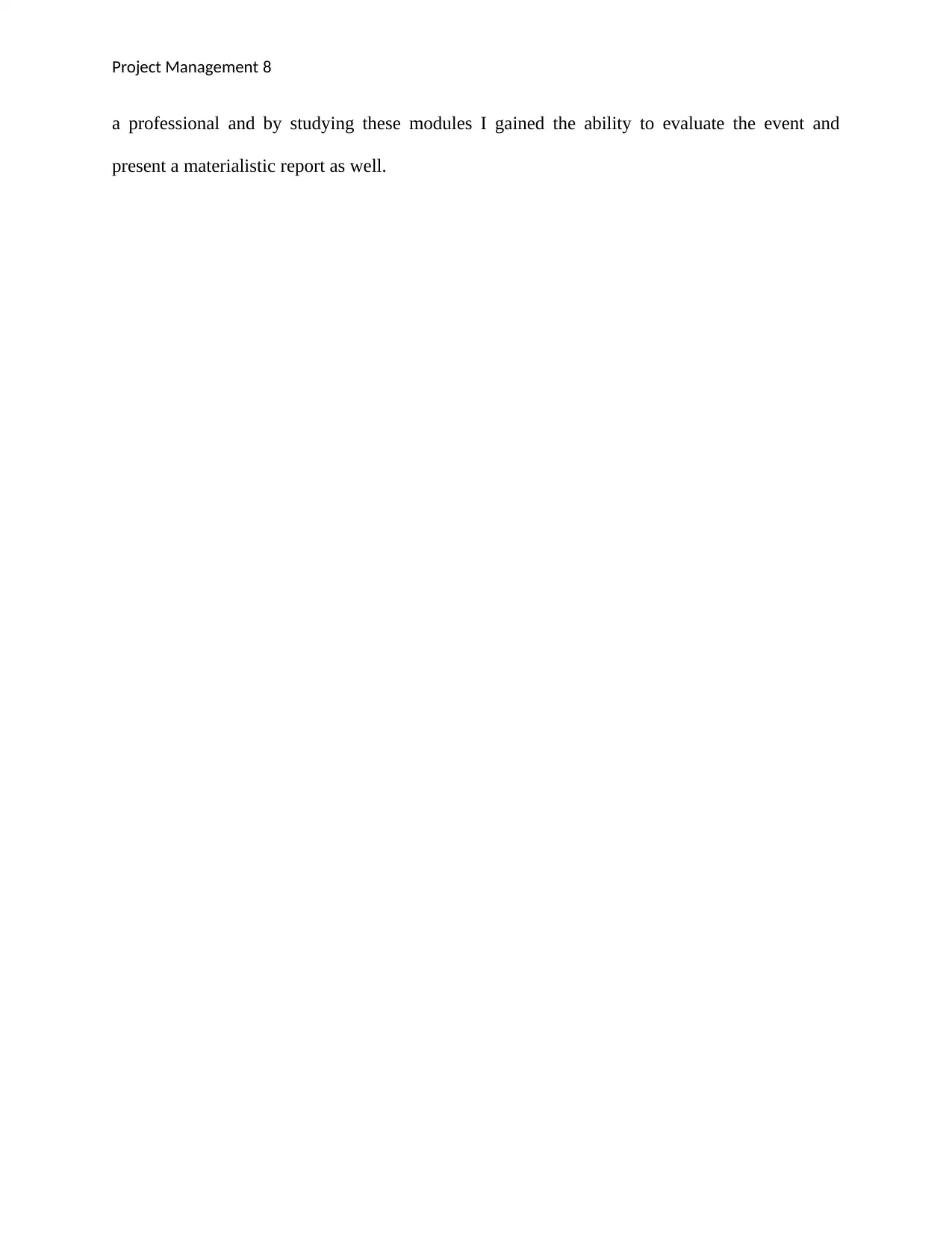
Project Management 8
a professional and by studying these modules I gained the ability to evaluate the event and
present a materialistic report as well.
a professional and by studying these modules I gained the ability to evaluate the event and
present a materialistic report as well.
⊘ This is a preview!⊘
Do you want full access?
Subscribe today to unlock all pages.

Trusted by 1+ million students worldwide
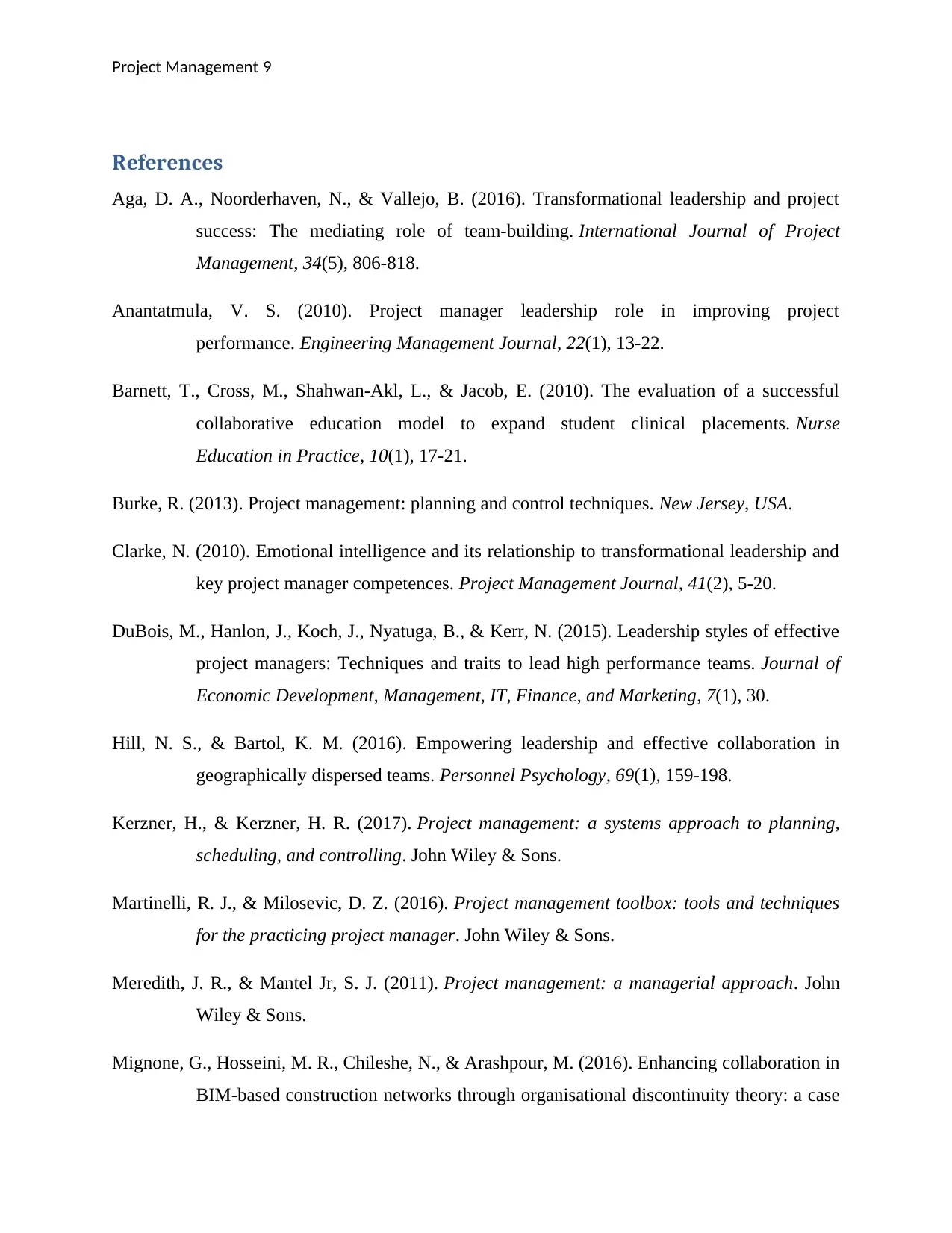
Project Management 9
References
Aga, D. A., Noorderhaven, N., & Vallejo, B. (2016). Transformational leadership and project
success: The mediating role of team-building. International Journal of Project
Management, 34(5), 806-818.
Anantatmula, V. S. (2010). Project manager leadership role in improving project
performance. Engineering Management Journal, 22(1), 13-22.
Barnett, T., Cross, M., Shahwan-Akl, L., & Jacob, E. (2010). The evaluation of a successful
collaborative education model to expand student clinical placements. Nurse
Education in Practice, 10(1), 17-21.
Burke, R. (2013). Project management: planning and control techniques. New Jersey, USA.
Clarke, N. (2010). Emotional intelligence and its relationship to transformational leadership and
key project manager competences. Project Management Journal, 41(2), 5-20.
DuBois, M., Hanlon, J., Koch, J., Nyatuga, B., & Kerr, N. (2015). Leadership styles of effective
project managers: Techniques and traits to lead high performance teams. Journal of
Economic Development, Management, IT, Finance, and Marketing, 7(1), 30.
Hill, N. S., & Bartol, K. M. (2016). Empowering leadership and effective collaboration in
geographically dispersed teams. Personnel Psychology, 69(1), 159-198.
Kerzner, H., & Kerzner, H. R. (2017). Project management: a systems approach to planning,
scheduling, and controlling. John Wiley & Sons.
Martinelli, R. J., & Milosevic, D. Z. (2016). Project management toolbox: tools and techniques
for the practicing project manager. John Wiley & Sons.
Meredith, J. R., & Mantel Jr, S. J. (2011). Project management: a managerial approach. John
Wiley & Sons.
Mignone, G., Hosseini, M. R., Chileshe, N., & Arashpour, M. (2016). Enhancing collaboration in
BIM-based construction networks through organisational discontinuity theory: a case
References
Aga, D. A., Noorderhaven, N., & Vallejo, B. (2016). Transformational leadership and project
success: The mediating role of team-building. International Journal of Project
Management, 34(5), 806-818.
Anantatmula, V. S. (2010). Project manager leadership role in improving project
performance. Engineering Management Journal, 22(1), 13-22.
Barnett, T., Cross, M., Shahwan-Akl, L., & Jacob, E. (2010). The evaluation of a successful
collaborative education model to expand student clinical placements. Nurse
Education in Practice, 10(1), 17-21.
Burke, R. (2013). Project management: planning and control techniques. New Jersey, USA.
Clarke, N. (2010). Emotional intelligence and its relationship to transformational leadership and
key project manager competences. Project Management Journal, 41(2), 5-20.
DuBois, M., Hanlon, J., Koch, J., Nyatuga, B., & Kerr, N. (2015). Leadership styles of effective
project managers: Techniques and traits to lead high performance teams. Journal of
Economic Development, Management, IT, Finance, and Marketing, 7(1), 30.
Hill, N. S., & Bartol, K. M. (2016). Empowering leadership and effective collaboration in
geographically dispersed teams. Personnel Psychology, 69(1), 159-198.
Kerzner, H., & Kerzner, H. R. (2017). Project management: a systems approach to planning,
scheduling, and controlling. John Wiley & Sons.
Martinelli, R. J., & Milosevic, D. Z. (2016). Project management toolbox: tools and techniques
for the practicing project manager. John Wiley & Sons.
Meredith, J. R., & Mantel Jr, S. J. (2011). Project management: a managerial approach. John
Wiley & Sons.
Mignone, G., Hosseini, M. R., Chileshe, N., & Arashpour, M. (2016). Enhancing collaboration in
BIM-based construction networks through organisational discontinuity theory: a case
Paraphrase This Document
Need a fresh take? Get an instant paraphrase of this document with our AI Paraphraser
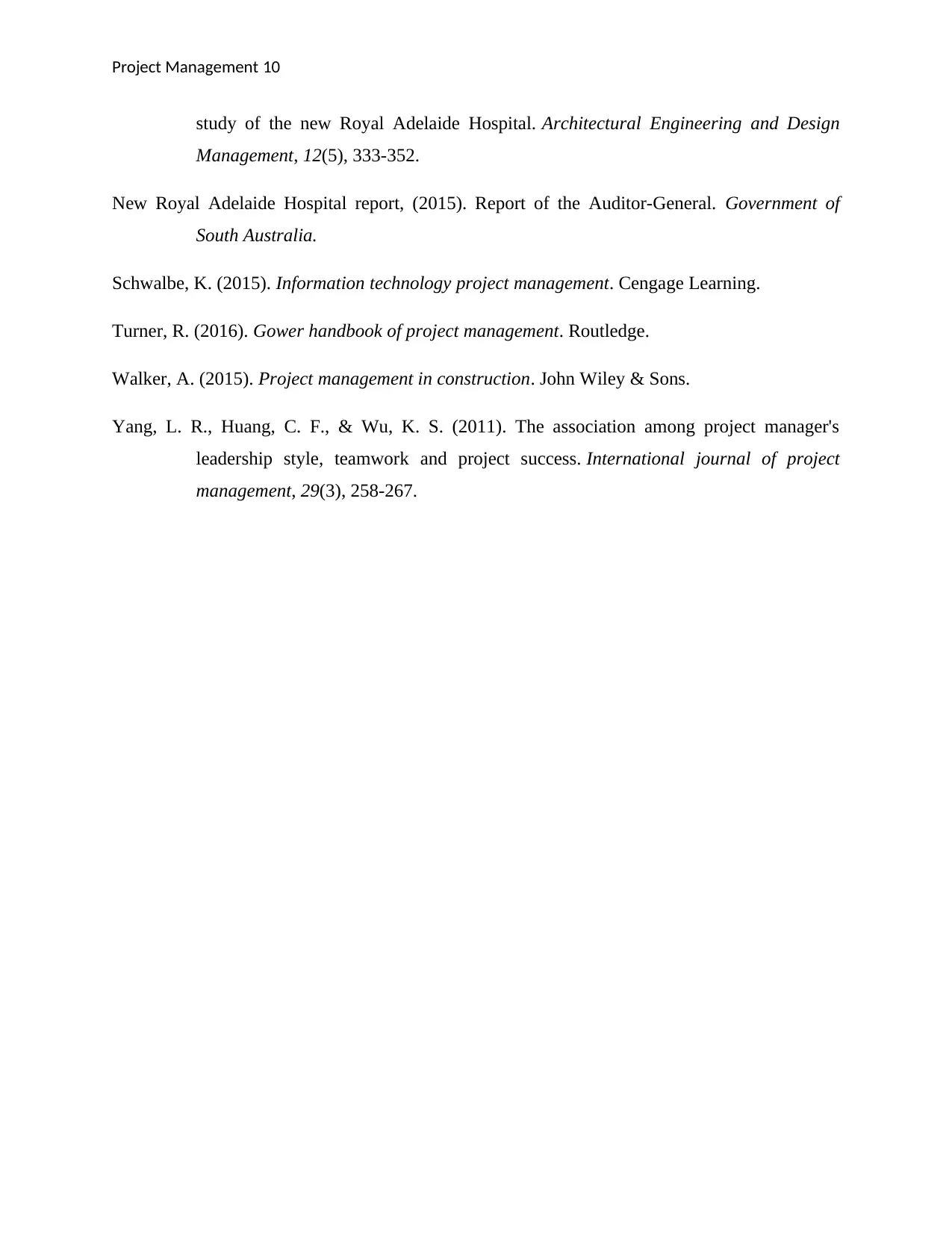
Project Management 10
study of the new Royal Adelaide Hospital. Architectural Engineering and Design
Management, 12(5), 333-352.
New Royal Adelaide Hospital report, (2015). Report of the Auditor-General. Government of
South Australia.
Schwalbe, K. (2015). Information technology project management. Cengage Learning.
Turner, R. (2016). Gower handbook of project management. Routledge.
Walker, A. (2015). Project management in construction. John Wiley & Sons.
Yang, L. R., Huang, C. F., & Wu, K. S. (2011). The association among project manager's
leadership style, teamwork and project success. International journal of project
management, 29(3), 258-267.
study of the new Royal Adelaide Hospital. Architectural Engineering and Design
Management, 12(5), 333-352.
New Royal Adelaide Hospital report, (2015). Report of the Auditor-General. Government of
South Australia.
Schwalbe, K. (2015). Information technology project management. Cengage Learning.
Turner, R. (2016). Gower handbook of project management. Routledge.
Walker, A. (2015). Project management in construction. John Wiley & Sons.
Yang, L. R., Huang, C. F., & Wu, K. S. (2011). The association among project manager's
leadership style, teamwork and project success. International journal of project
management, 29(3), 258-267.
1 out of 11
Related Documents
Your All-in-One AI-Powered Toolkit for Academic Success.
+13062052269
info@desklib.com
Available 24*7 on WhatsApp / Email
![[object Object]](/_next/static/media/star-bottom.7253800d.svg)
Unlock your academic potential
Copyright © 2020–2025 A2Z Services. All Rights Reserved. Developed and managed by ZUCOL.





